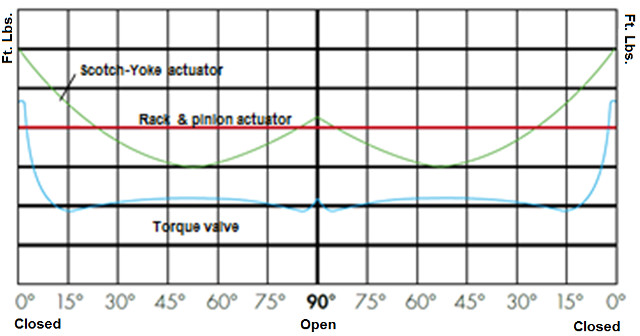Garlock’s primary actuator offering is the Scotch Yoke pneumatic actuator; however, we can offer electric actuators upon request. This section will focus on the advantages of Scotch Yoke over rack and pinion.
Rack and Pinion vs. Scotch Yoke
Rack and pinion uses a rack and a pinion gear to open and close the stem. This creates a level, linear torque to open and close the valve. This actuator can be used for both on/off and throttling.
Scotch Yoke uses the cam principle, which varies the torque to open and close the valve. This actuator is unable to hold a mid-point position, and therefore cannot be used for control purposes (i.e. throttling).
Rack and Pinion

Scotch Yoke

Butterfly valves require different torques depending on where the disc is in the open/close cycle. When the disc is just starting to open (0-10⁰) or nearly closed (10-0⁰), it requires the highest torque. During the remainder of the disc movement, it requires much less torque.
When the sides of the disc are pressing against the liner, it requires more force to move.
Scotch Yoke actuators closely align with the torque needs of a butterfly valve; from 0-20⁰ and 20⁰-0, it applies 50% more torque than during the remainder of the cycle. This creates a smooth opening and closing, and extends actuator and valve liner life.
Rack and Pinion actuators better align with the torque needs of ball valves. When using them on a butterfly valve, you can select an actuator that will cover the maximum valve torque or the average. If the maximum torque is selected, the actuator is overworking for 95% of the actuation cycle. If the average torque is selected, the actuator is underperforming when the disc is closed and could lead to accelerated actuator wear.

Advantages of our Garlock Actuator
- 60% more efficient (energy savings)
- 30% lighter
- Guaranteed 2,000,000 cycles over lifetime
Actuator Accessories
- Limit Switches
- Positioners
- Etc.




